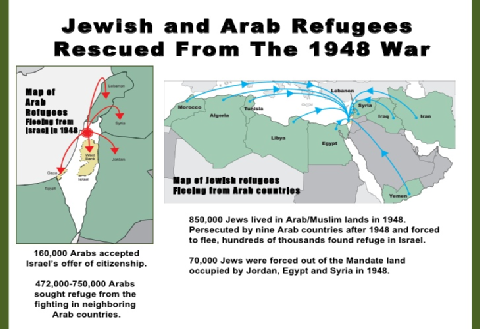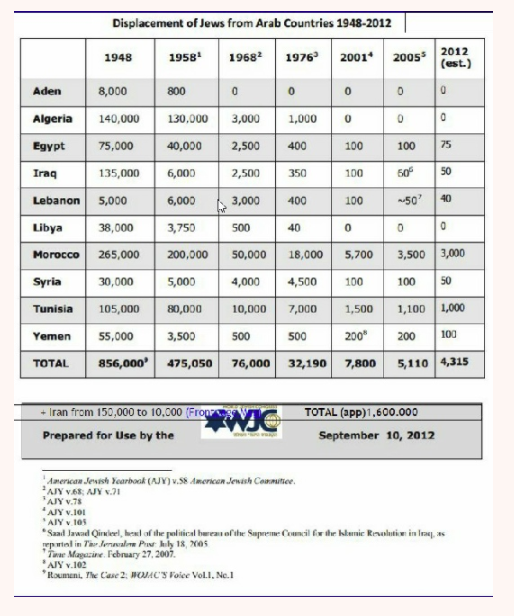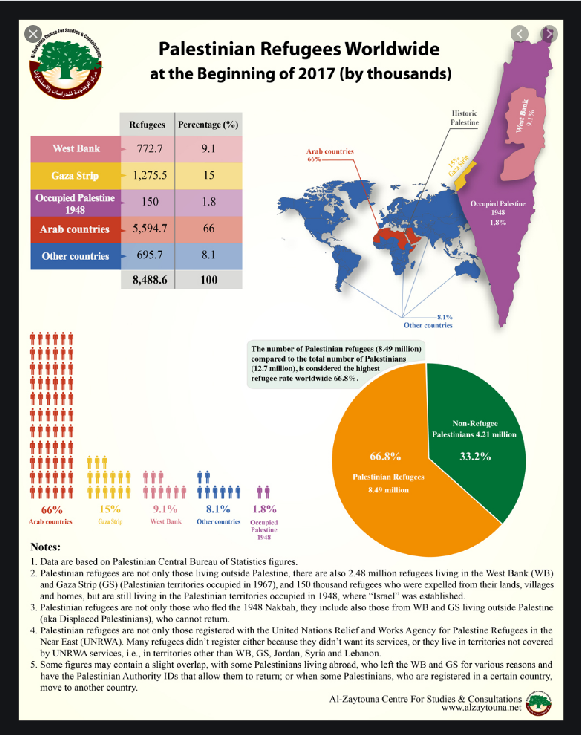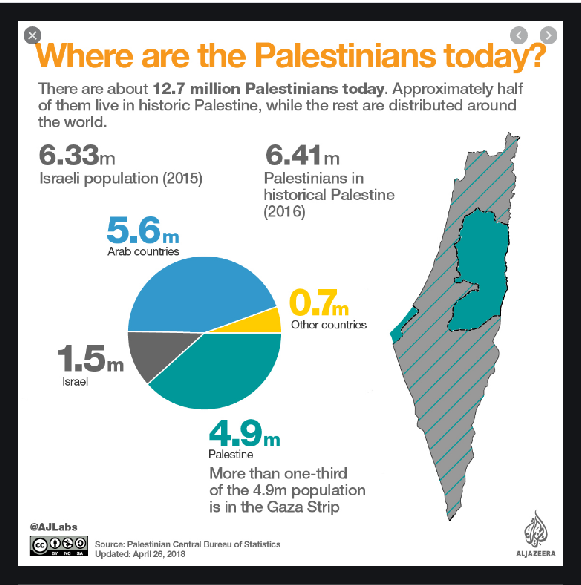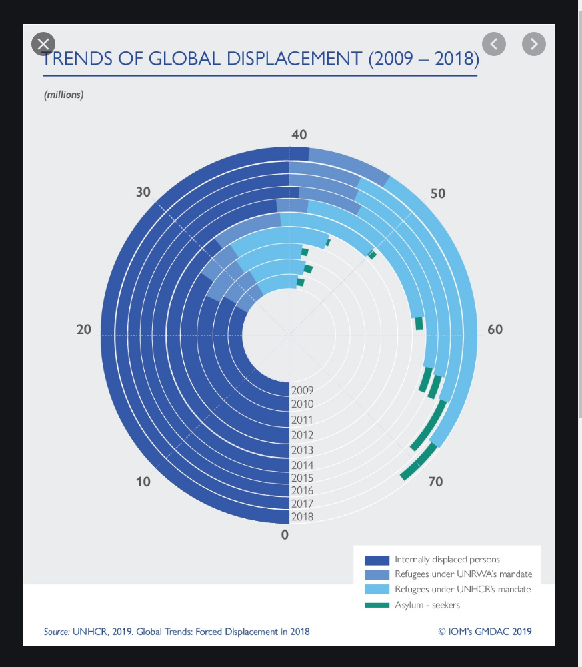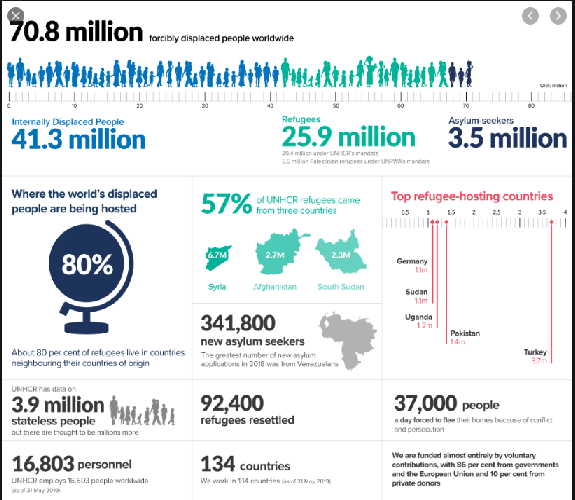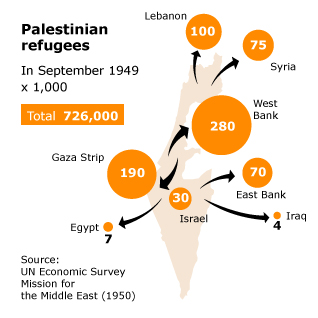
|
|
|
|
|
|
|
|
|
|
|
|
|
|
|
Payments to Jailed Palestinians and ‘Martyrs’ by the Palestinian AuthorityP |
|
|
|
|
|
|
|
|
|
PART 1 T O P I C |
|
|
|
|
|
|
|
|
|
|
|
|
|
|
|
|
|
|
JewishWikipedia.info
|
Shift to UNHCR Criteria Would Strip Refugee Status From Millions of Palestinians |
NRWA HAS CHANGED THE DEFINITION OF REFUGEE
The U.N.'s agency for Palestinians should
stop playing word games and do its job.
FP (Foreign Policy) Jay Sekulow August 17, 2018
Jay Sekulow is chief counsel of the American Center for Law & Justice and serves as counsel to U.S. President Donald Trump.
Last week, Foreign Policy published a story about Palestinian refugees that claimed I am among the “activists trying to strip Palestinians of their status.” The article obscured basic facts about the matters at hand—both my own role as a policy advocate and the questions that lawmakers in Congress are presently considering that pertain to the United Nations Relief and Works Agency for Palestine Refugees in the Near East (UNRWA). I feel compelled to correct the record on both points.
This requires first understanding the legal facts. UNRWA was founded in 1949 through U.N. General Assembly Resolution 302 at the conclusion of the Arab-Israeli conflict of 1948, aiming for “the alleviation of the conditions of starvation and distress among the Palestine refugees” from that conflict. The agency defines Palestinian refugees as “persons whose normal place of residence was Palestine during the period 1 June 1946 to 15 May 1948, and who lost both home and means of livelihood as a result of the 1948 conflict.”
In 1965, UNRWA changed the eligibility requirements to be a Palestinian refugee to include third-generation descendants, and in 1982, it extended it again, to include all descendants of Palestine refugee males, including legally adopted children, regardless of whether they had been granted citizenship elsewhere. This classification process is inconsistent with how all other refugees in the world are classified, including the definition used by the United Nations High Commissioner for Refugees (UNHCR) and the laws concerning refugees in the United States.
Under Article I(c)(3) of the 1951 U.N. Convention and Protocol Relating to the Status of Refugees, a person is no longer a refugee if, for example, he or she has “acquired a new nationality, and enjoys the protection of the country of his new nationality.” UNRWA’s definition of a Palestinian refugee, which is not anchored in treaty, includes no such provision.
Last month, members of Congress introduced a bill asking that with respect to refugees under UNRWA the policy of the United States should be consistent with the definition of a refugee in the Immigration and Nationality Act, such that “derivative refugee status may only be extended to the spouse or minor child of such a refugee” and “an alien who was firmly resettled in any country is not eligible to retain refugee status.”
Foreign Policy’s article includes a claim that deserves closer scrutiny and reflects the sleight of hand often performed by UNRWA. The author writes:
“Palestinians, [Sekulow and his organization] claim, are the only refugees in the world who pass on their refugee status through the generations. The view is not shared by the U.N. High Commissioner for Refugees (UNHCR), and the State Department, which maintain that multiple generations of Afghan, Bhutanese, Burmese, Nepalese, Thai, Tibetan, and Somali people have been recognized as refugees.”
The clear implication of that paragraph, and the similar claims made by UNRWA, is that the laws I have cited above are wrong, that UNRWA’s definition of a refugee is consistent with the standard definition, and that in all of these cases the descendants of refugees are considered to be refugees as well. In actuality, what the article has done is to conflate two different issues.
The 1951 refugee convention has a lengthy definition of refugee that is personal: A refugee is a person who “owing to well-founded fear of being persecuted for reasons of race, religion, nationality, membership of a particular social group or political opinion, is outside the country of his nationality and is unable or, owing to such fear, is unwilling to avail himself of the protection of that country.” In registering refugees on this basis, the UNHCR interprets the convention as requiring “family unity,” and it implements the principle by extending benefits to a refugee’s accompanying family, calling such people “derivative refugees.” Derivative refugees do not have refugee status on their own; it depends on the principal refugee. UNRWA’s definition is also personal: Palestinian refugees are “persons whose normal place of residence was Palestine during the period 1 June 1946 to 15 May 1948, and who lost both home and means of livelihood as a result of the 1948 conflict,” but it also registers “descendants of Palestine refugee males, including adopted children.” The status for descendants is not dependent upon accompanying the principal refugee.
Here is where the sleight of hand comes in: Of course it is possible for there to be multiple generations of refugees, if the multiple generations all fit the primary 1951 definition of a refugee. For example, if the granddaughter of a refugee is also outside the country of her nationality due to a well-founded fear of being persecuted, she too is a primary refugee. But she is not a refugee due to descent, because there is no provision for refugee status based on descent in the 1951 refugee convention or in internationally accepted practices for refugees who are not Palestinian refugees.
Those are the laws. Now, consider the broader political facts. Since the end of World War II, millions of refugees have left refugee camps and have been resettled elsewhere, including hundreds of thousands of Jewish people who were forced out of Arab countries. Many hardworking agencies have played a role in making sure that the descendants of these refugees were never refugees themselves. These agencies include the UNHCR, whose mandate is to protect refugees, forcibly displaced communities, and stateless people, and assist in their voluntary repatriation, local integration, or resettlement to a third country.
The only refugees who do not fall under the UNHCR and instead have their own agency are the Palestinians. While the UNHCR has resettled millions of refugees, since the time it was created, UNRWA has not managed to solve or even diminish the problem at all. Instead, using its own metrics, the number of refugees has grown exponentially, while UNRWA has become one of the larger U.N. agencies, with 30,000 personnel and a $1.2 billion budget. This is despite the fact that many of the UNRWA “refugees” are not actually refugees at all under the standard international definition of that term. For example, of the 2 million Palestinian refugees in Jordan, most have been granted Jordanian citizenship.
UNRWA, moreover, is the only refugee agency in the world whose purpose is not to resettle refugees and help them go on with their lives. UNRWA spends more to do less, while perpetuating a problem it was created to help solve. This situation, which does little to advance the interests of actual refugees and much to expand a bloated UNRWA bureaucracy, needs to be addressed.
The United States has been UNRWA’s biggest donor since its inception and contributes a disproportionate amount toward Palestinian refugees in comparison to other refugees around the world. What I, and concerned citizens including members of Congress and members of the American Center for Law & Justice (ACLJ), are asking is that the United States support UNRWA solely to the extent necessary to accomplish its original and intended purpose to resettle refugees from the Arab-Israeli conflict of 1948 under the internationally recognized definition of refugees that applies in every other instance.
In the words of Lt. Gen. Alexander Galloway, then the director of UNRWA in Jordan, in 1952:
It is perfectly clear that Arab nations do not want to solve the Arab refugee problem. They want to keep it as an open sore, as an affront against the United Nations and as a weapon against Israel. Arab leaders don’t give a damn whether the refugees live or die.
We at the ACLJ, on the other hand, do believe that U.N. agencies should exist to solve problems and help people. We are calling on the United States to do this for the sake of everyone involved, including the legitimate refugees who deserve better treatment than a failed agency like UNRWA can apparently provide.
FACTS, FIGURES AND SIGNIFICANCE
The Institute of National Security Studies,
Tel Aviv university, Israela Oron, February 18, 2018
In contrast to figures on UNRWA’s official site, which cite 526,700 registered refugees in Lebanon, newly published figures based on a Lebanese census conducted in cooperation with the Palestinian Central Bureau of Statistics estimate their number at 175,000. This figure is interesting in itself, because of the familiar tendency of Palestinian elements to be reluctant to reduce the number of refugees. More specifically, the situation of the refugees in Lebanon has always been considered worse than in other countries, due to the strong restrictions there against them. Therefore, it is generally accepted that they be dealt with first in any settlement. Even when ideas were proposed for a symbolic return of refugees to Israel in the framework of family reunification, refugees from Lebanon were spoken of first. The gap in the figures strengthens the assumption that the numbers on the UNRWA site do not reflect reality – not only in Lebanon, but also in other countries. This assumption undermines the reliability of this organization, which has always been seen in Israel as a hostile entity at the forefront of the struggle to perpetuate the refugee issue and the demand for the "right of return."
UNFPA (UN Population Fund), 21 December 2016
Speaking with UN Radio, Anders Thomsen, UNFPA (UN Population Fund) Representative to the State of Palestine about the current trends and the anticipated impacts said: “Fertility rates are twice the rate of those in the more advanced areas in the region – a trend that is expected to bring its population from the current 4.7 million to 6.9 by 2030 and to 9.5 million by 2050. The highest rate of growth is expected to occur in Gaza, where the report estimates a population of 1.85 million will reach 3.1 million by 2030 and 4.7 million by 2050.”
PALESTINIAN REFUGEES
ADL
The Palestinian refugee issue originated in the 1948 Arab-Israeli war, when five Arab armies invaded the State of Israel just hours after it was established. During the ensuing war, as many as 750,000 Palestinian Arabs fled their homes in the newly created state as a result of many factors. Some of the Palestinian Arabs who fled did so to avoid the ongoing war or at the urging of Arab leaders, and expected to return after a quick and certain Arab victory over the new Jewish state. Other Palestinians were forced to flee by individuals or groups fighting for Israel.
Of the Palestinians who left, one-third went to the West Bank (which was under Jordanian control), one-third went to the Gaza Strip (under Egypt’s control), and the remainder to Jordan, Lebanon and Syria.
The Arab nations refused to absorb these Palestinians into their societies and they were instead settled into refugee camps, insisting that citizen and integration would undermine the refugees’ right to return to their homes in Palestine. Only Jordan’s King Abdullah conferred citizenship on the 200,000 Palestinian living in Jordan and the Jordanian-controlled West Bank and East Jerusalem. In 1949, the United Nations Relief and Works Agency for Palestinian Refugees in the Near East (UNRWA) was created to oversee the economic integration of the refugees into these Arab countries. UNRWA continues to operate, providing relief, health care, education and vocational training to the refugee populations in Jordan, Syria, Lebanon, the West Bank and Gaza Strip.
During the 1967 Six Day War, another estimated 250,000 Palestinians fled the West Bank and Gaza Strip with the arrival of Israeli forces. Some of these were people who had left their homes in Israel in 1948. These individuals are considered by the international community to be displaced persons, not refugees.
A Jewish refugee problem was also created with the establishment of the State of Israel. From 1948-1951 as many as 800,000 Jews were expelled from their native Arab and Muslim nations or forced to flee as a result of state-sponsored anti-Zionist violence. They left behind their property and the lives they had built in these lands over hundreds of years. As many as 500,000 of these refugees fled from Iraq, Tunisia, Syria, Egypt, Yemen, Algeria, Libya and Morocco and were absorbed into the new State of Israel. Others fled to Europe and North and South America.
Tallying the number of individuals considered Palestinian refugees today is a matter of intense debate. UNRWA, classifies Palestinian refugees as those who left Israel in 1948; those who left the West Bank and Gaza Strip in 1967; those who were abroad but were subsequently not allowed to return to Israel; and all of their descendants. According to UNRWA, this totals five million Palestinian refugees. UNRWA’s statistics include those residing in Jordan, Lebanon, Syria, the West Bank and Gaza Strip. (Note: UNRWA’s policy of including the children, grandchildren and great-grandchildren of those who left in 1948 and 1967 into the refugee population for demographic and aid purposes is unique among refugee populations, and is not a done for any other refugee group.)
Israel believes the UNRWA statistics are exaggerated and further distinguishes “refugees” from “displaced persons” and from “expired permit Palestinians” who were abroad at the time the conflicts ensued and were not allowed to return.
Palestinian insistence that refugees must have a “right of return” to their former homes inside Israel, and that this “right” is founded in international law, is rejected by Israel. Israel denies that there is any foundation in international law for a Palestinian “right of return,” and that the non-binding international resolutions on the issue call not for a “return” to Israel, but for a just resolution of the refugee problem. Since the start of the Oslo process, refugees are considered one of the “final status” issues, along with borders, security, settlements and Jerusalem, that are to be negotiated as part of a final Israeli-Palestinian agreement.
Israel also argues that a “return” is not viable for such a small state, given that the influx of millions of Palestinians into Israel would pose a threat to its national security and upset the country’s demographic makeup. In the decades that the Palestine Liberation Organization (PLO) did not recognize Israel’s right to exist and actively sought to bring about Israel’s downfall and replace it with a Palestinian state, the “right of return” of Palestinian refugees was a rallying cry. In 1993, the PLO recognized Israel's right to exist and committed to a negotiating process to establish an independent Palestinian state alongside the State of Israel. Given this reality, American Presidents including President Bill Clinton, President George W. Bush and President Barack Obama have publicly stated that Palestinian refugees should rightly be resettled in a future Palestinian state and not inside Israel.
Israel maintains that it is not responsible for the Palestinian refugee problem since it is the result of a war forced on Israel by invading Arab armies. However, Israel has stated that on humanitarian grounds it would participate in an international effort to resolve the situation. Such an effort would be a result of a mutually negotiated peace agreement and likely involve Palestinian refugees settling in newly established state of Palestine, an international compensation fund, and individual cases of family reunification.
Any international effort would also need to consider the situation of the 800,000 Jews who were expelled from their native Arab and Muslim nations or forced to flee as a result of state-sponsored anti-Jewish violence following the founding of the State of Israel.
SHIFT TO UNHCR CRITERIA WOULD STRIP REFUGEE STATUS FROM MILLIONS OF PALESTINIANS
Unlike UNRWA, now defunded by Trump, the UN’s global refugee body doesn’t confer refugee status on those who have citizenship elsewhere, and it treats descendants differently
Times of Israel Adam Rasgon, 6 September 2018
Were responsibility for the designation transferred to the UNHCR, millions of Palestinians would lose their refugee status — which is a key factor in the longstanding demand by the Palestinian leadership for refugees to be granted a “right of return” to today’s Israel. How many exactly of the 5.4 million Palestinians registered by UNRWA as refugees would lose that designation under UNHCR? It’s complicated, as we will see.
But based on a comparison of UNRWA’s refugee figures and the assessments of James Lindsay, a former UNRWA legal adviser who has written extensively on the differences between UNHCR and UNRWA, almost all of Jordan’s 2.2 million UNRWA-designated refugees would likely lose their status under UNHCR criteria, as would most of Syria’s 560,000 and just under half of Lebanon’s 521,000. All 2.17 million UNRWA-designated refugees in Gaza, the West Bank and East Jerusalem would lose that status were those areas to become parts of a sovereign Palestinian state. This would leave a refugee total of a little over half a million.
Hundreds of thousands of Palestinians left or fled what is today’s Israel at the time of the 1948 Arab-Israel war, known in Israel as the War of Independence. Ever since, their leadership has demanded in intermittent negotiations with Israel that they and their descendants be allowed to “return,” although Palestinian Authority President Mahmoud Abbas has also said outside of the formal negotiating framework that he would not seek to destroy or drown Israel as a Jewish state by weight of such an influx.
Israel argues that the demand for a “right of return” for millions represents precisely such an effort to dramatically alter Israel’s 75 percent to 25 percent Jewish/non-Jewish demographic balance via an influx of millions of Palestinians — that is, to seek a Palestinian state in the West Bank, East Jerusalem and Gaza, and to turn Israel into a second Palestinian state. Since there are estimated to be only a few tens of thousands of original Palestinian refugees still alive, Israel has charged that UNRWA, by extending refugee status to millions of descendants, perpetuates and inflates the issue. Hence its hostility to UNRWA, and hence Netanyahu’s publicly stated support for closing UNRWA, and channeling aid to needy Palestinians via other agencies and parties.
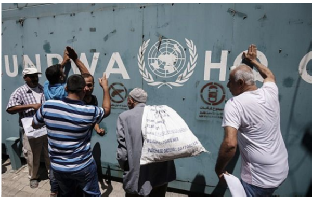 Employees of the UN Relief and Works Agency for Palestine Refugees in the Near East (UNRWA) and their families protest against job cuts announced by the agency outside its offices in Gaza City on July 31, 2018.
Employees of the UN Relief and Works Agency for Palestine Refugees in the Near East (UNRWA) and their families protest against job cuts announced by the agency outside its offices in Gaza City on July 31, 2018.
(AFP PHOTO / SAID KHATIB)
At the end of August, the State Department said in a written statement that the US “will no longer commit further funding to this irredeemably flawed operation,” referring to UNRWA. “The fundamental business model and fiscal practices that have marked UNRWA for years – tied to UNRWA’s endlessly and exponentially expanding community of entitled beneficiaries – is simply unsustainable and has been in crisis mode for many years,” the statement said, adding that the US would now dialogue with the UN and other international stakeholders about “new models and approaches” to aiding the Palestinians served by UNRWA.
The European Union subsequently called on the US to reconsider, but also urged UNRWA to carry out reforms and an unspecified “transformative process.” It was unclear whether the EU meant, by this, that UNRWA should reconsider how it designates Palestinian refugees. “The regrettable decision of the US to no longer be part of this international and multilateral effort leaves a substantial gap and we hope that the US can reconsider their decision,” the EU’s spokesperson said in a statement. “UNRWA has recently expanded its donor base and taken internal management measures to increase efficiencies and reduce costs. UNRWA should pursue these reforms and further engage in a transformative process.”
UNRWA spokesman Chris Gunness rejected the State Department’s criticisms and pointed out that international parties have praised the UN agency’s work.
“We reject in the strongest possible terms the criticism that UNRWA’s schools, health centers, and emergency assistance programs are ‘irredeemably flawed’… The international state community, our donors and host countries have consistently praised UNRWA for its achievements and standards,” Gunness said in a statement the day after the US announcement.
Jordanian Foreign Minister Ayman al-Safadi vowed Jordan would do everything it could to keep the UN body running.
For his part, Saeb Erekat, secretary-general of the PLO Executive Committee, slammed the US funding cut to UNRWA, describing it as “a violation of international law,” and called on the international community to step up its support to the UN agency.
HOW DOES UNHCR DEFINE A REFUGEE?
The UNHCR, the UN’s global refugee agency, as opposed to UNRWA, which serves only Palestinians, defines a refugee based on the Convention Relating to the Status of Refugees, which was adopted by United Nations Conference of Plenipotentiaries on the Status of Refugees and Stateless Persons in 1951.
The convention initially only applied to persons who had fled “events in Europe before January 1, 1951,” namely World War II and the Holocaust. However, it was later amended in 1967 to expand its definition to persons fleeing persecution outside of Europe after January 1, 1951. (A total of 145 countries have ratified the convention, according to the UNHCR website.)
The convention defines a refugee in its first article:
Any person who owing to well-founded fear of being persecuted for reasons of race, religion, nationality, membership of a particular social group or political opinion, is outside the country of his nationality and is unable or, owing to such fear, is unwilling to avail himself of the protection of that country; or who, not having a nationality and being outside the country of his former habitual residence as a result of such events, is unable or, owing to such fear, is unwilling to return to it.
But the convention also outlines a number of circumstances which disqualify persons who fall under its definition of a refugee from gaining refugee status.
The convention says, for instance, that if a person fleeing persecution has acquired citizenship in a country in which they have sought refuge, he or she would not be eligible to receive refugee status. It also states that this applies if the person has gained the rights of a citizen in the country of refuge, even without gaining citizenship.
HOW DOES UNRWA DEFINE A REFUGEE?
UNRWA defines refugees as “persons whose normal place of residence was Palestine during the period 1 June 1946 to 15 May 1948, and who lost both home and means of livelihood as a result of the 1948 conflict.”
UNRWA’s definition also states that “services are available to all those living in its area of operations… who are registered with the Agency and who need assistance” and that “the descendants of Palestine refugee males, including adopted children, are also eligible for registration.”
UNRWA provides education, health, social welfare and other services to Palestinians it has registered as refugees in five geographical regions: Jordan, Syria, Lebanon, the Gaza Strip, the West Bank and East Jerusalem.
According to UNRWA’s figures, 515,260 Palestinians whom it has registered as refugees study in its 677 schools; 3.1 million access its healthcare system at its 139 health centers; more than 250,000 receive welfare from its social safety net program, and thousands of others receive small loans from its micro-finance department. UNRWA also employs some 30,000 Palestinians.
In total, Gunness has said that UNRWA has registered 5.4 million Palestinians as refugees.
UNRWA’s website, which last updated its numbers in March 2018, says the organization has registered 2.2 million Palestinian refugees in Jordan; 560,000 in Syria, of whom an estimated 438,000 live in the country; 521,592 in Lebanon, of whom 260,000 to 280,000 reside there; 1.34 million in Gaza; and some 818,000 in the West Bank and East Jerusalem. (In all, that makes for 5.44 million Palestinians registered as refugees; when those no longer living in Syria and Lebanon are deducted, the total is 5.07 million.)
ISSUE OF CITIZENSHIP
A key difference between the UNHCR and UNRWA definitions concerns how the two organizations relate to people who have acquired either citizenship or the rights of citizens in the countries where they have sought refuge.
The UNHCR’s definition of a refugee does not extend to persons who have acquired such rights; UNRWA’s does. Thus, many Palestinians would not have refugee status had UNHCR been the party to determine their eligibility, according to Lindsay, the former senior UNRWA official.
The UNHCR has not specified which Palestinians registered as refugees by UNRWA would meet its criteria for refugee status. But Lindsay, a former legal adviser and general counsel for UNRWA, has written extensively on the issue.
In articles he authored for the winter 2014-2015 edition of Justice, a magazine published by the International Association of Jewish Lawyers and Jurists, and the fall 2012 edition of the Middle East Quarterly, a journal published by the Middle East Forum, a Philadelphia-based think tank, he broke down the status of Palestinians registered by UNRWA as refugees in the various regions, and explored whether UNHCR would regard them as refugees. (Since he wrote those articles some four years and six years ago, respectively, the numbers he uses are lower than the current figures.)
Jordan
In Jordan, Lindsay holds that some 1.8 million UNRWA-registered Palestinian refugees would be stripped of their refugee status under UNHCR criteria.
This is because more than 90 percent of 2.2 million Palestinians who UNRWA has registered as refugees have Jordanian citizenship. (After Jordan took over the West Bank in 1949, it granted all Palestinians within its borders citizenship.)
Syria
In Syria, Lindsay maintains that some 425,000 Palestinians who UNRWA counts as refugees would “almost certainly” be denied their refugee status under UNHCR.
Under Law 260, Syrian legislation passed in 1956, Palestinians in Syria registered by UNRWA as refugees enjoy most of the rights of Syrians with the major exceptions of suffrage and citizenship.
The Gaza Strip and the West Bank
In the Gaza Strip and the West Bank, Lindsay does not definitively state whether UNRWA-registered Palestinian refugees would retain their refugee status under UNHCR criteria.
He mentions that the two million-plus Palestinians who UNRWA has registered as refugees in these areas “have exactly the same rights as the non-refugee population, including suffrage,” but he notes that it is unclear if they are considered citizens of a state.
More than 130 countries have recognized the “State of Palestine,” which holds non-member observer status at the UN, but many world powers have yet to do so.
Nonetheless, Lindsay asserts that if a Palestinian state “came into existence,” UNHCR would not allow Palestinians who UNRWA has registered as refugees to maintain their refugee status.
Lebanon
In Lebanon, Lindsay maintains that some 250,000 Palestinians who UNRWA has registered as refugees would retain their refugees status.
Many Palestinians who UNRWA has registered as refugees do not have Lebanese citizenship, nor do they have the rights of Lebanese citizens. They are barred from many professions, cannot own property, and are denied access to Lebanese public schools and national health services.
(UNRWA’s website says it has registered approximately 521,592 Palestinians as refugees in Lebanon of whom only 260,000-280,000 live in Lebanon. Since Lindsay published his articles, however, a joint census carried out by the Lebanese and Palestinian Authority statistics bureaus in 2017 counted a total of 174,422 Palestinian refugees in Lebanon.)
UNRWA’S RESPONSE
Asked why UNRWA grants refugee status to Palestinians who have gained citizenship or the rights of citizens in the countries where they sought refuge, Gunness, the UNRWA spokesman, said the UN General Assembly is the party that approves UNRWA’s definition of a refugee, and that it is the General Assembly, not UNRWA, that has the authority to change it.
“It is the General Assembly that approved the definition of Palestine refugees that has essentially remained the same since the beginning of UNRWA operations. The General Assembly has been mandating UNRWA to deliver services to this population on the basis of the definition. It includes registration and eligibility for services of children of Palestine refugees (through the male line). Registration and eligibility for services has never been conditional on lack of nationality,” he said.
UNRWA spokesman Chris Gunness at the 2014 International Media Seminar on Peace in the Middle East, Sophia University, Tokyo, June 9-10, 2014. (United Nations/John Gillespie/Wikipedia/CC BY-SA 2.0)
“Criteria for registration with UNRWA and service eligibility is a matter that is distinct from refugee status under the 1951 Refugee Convention,” he added. “Palestine refugees within UNRWA’s area of operation are excluded from the protection under the 1951 Refugee Convention (by virtue of Article 1D of that Convention). UNRWA does not have the authority to change the legal regime applicable to Palestine refugees under international law or its mandate from the General Assembly.”
ISSUE OF DESCENDANTS
UNRWA and UNHCR also differ in their handling of the descendants of refugees.
UNRWA allows descendants of male refugees to register as refugees with it and obtain access to its services. UNHCR does not explicitly mention descendants of refugees in its definition, but the UNHCR Handbook on Procedures and Criteria for Determining Refugee Status says that if the head of a family meets its definition of a refugee, his or her dependents normally qualify for refugee status as well.
In contrast to UNRWA, the UNHCR handbook, however, also mentions that granting refugee status to a dependent who “is a national of the country of asylum or of another country… would not be called for.”
Pierre Krahenbuhl, head of the United Nations Relief and Works Agency for Palestinian refugees, is interviewed in Jerusalem on January 19, 2018. (AFP Photo/Thomas Coex)
Pierre Krahenbuhl, UNRWA’s commissioner-general, recently told Foreign Policy magazine that persons who UNHCR and UNRWA have registered as refugees are allowed to pass their refugee status to their children and grandchildren.
He cited an example of Afghans who fled to Pakistan in the late 1970s and gained UNHCR refugee status there. He said that some of those Afghans still receive support from UNHCR, as do their children who were born after they arrived in Pakistan.
The UNHCR has also registered the descendants of refugees from Angola, Bhutan, Burma, the Democratic Republic of Congo, Eritrea, Somalia, Sudan, Tibet and other countries.
Lindsay recognizes Krahenbuhl’s point in his articles, but also notes that UNRWA and UNHCR still have distinct policies in dealing with descendants of refugees.
“The scandal, then, is not that refugee status can be passed from generation to generation, but rather that through inaction, refugee status is allowed to persist from generation to generation. For UNRWA Refugees, refugee status persists solely because UNRWA pretends persons who are protected by a state (the oxymoronic “citizen refugees”) are still refugees and, for those who really are refugees, refuses to make any effort to end their refugee status, as (in the absence of the possibility of repatriation) by resettlement or local integration,” Lindsey wrote in his article in Justice.
UNRWA does not resettle Palestinians it has registered as refugees, whereas UNHCR often employs that option when people it counts as refugees cannot return to their home country.
CLASSIFIED US REPORT:
PALESTINIAN REFUGEES NUMBER ONLY 30,000
Palestinian refugees number only several thousand,
and not the millions claimed by the Palestinians,
according to a classified State Department document.
United with Israel , United with Israel Staff, Apr 29, 2018
Palestinian refugees worldwide number only some 30,000, and not the millions claimed by the Palestinians, according to a classified Obama-era report on the issue.
The Free Beacon on Friday reported that the US government continues to keep this explosive report classified. Congressional officials view the document as a potential game changer in how the US approaches its regional policies and allocates billions in taxpayer funds, including information that could deeply impact the diplomatic process.
Citing multiple sources with knowledge of the report, the Free Beacon reported that the State Department continues to keep the report secret in order to not disrupt billions of dollars in allocations to United Nations Relief Works Agency for Palestine Refugees in the Near East (UNRWA), the organization responsible for providing aid to what they claim are some 5.2 million Palestinian refugees.
Those familiar with the report say the US had determined that the actual number of Palestinian refugees is far smaller, closer to around 30,000.
In a letter penned earlier this month, more than 50 members of Congress called on President Donald Trump to release the report, as mandated by US law.
Those familiar with the classified report’s contents told the Free Beacon that the State Department is intentionally trying to keep the document secret because of the political implications of its release.
The report’s findings could prompt real progress in the peace process by redefining the parameters of the debate on Palestinian refugees’ right of return to the Jewish state.
“As long as you have a right to return for millions of people, there’s no way in the world the Israeli government would agree to or could agree. If you could redefine refugees as a number that is manageable and fair and represents the reality, that becomes, instead of a stumbling block, it becomes a building block on trying to reinvigorate the peace process,” Congressman Chris Stewart (R, Utah) said.
Asked about the document’s classified status, Stewart responded, “there’s no reason in the world it’s classified. The reason it’s classified is because it’s a political document that the administration just didn’t” want to release publicly.
“Is it a meaningful document?” Stewart added “Absolutely. Is it information that should be shared in the world community? Absolutely. If this information was shared and we were to take a practical look at this, would it help in negotiating a peace proposal? I believe it absolutely would.”
PALESTINIAN REFUGEES’ UNIQUE STATUS
The Palestinians have a unique definition for their status as refugees.The number of Palestinian refugees has been vastly inflated by the fact that refugee status is passed on to succeeding generations and is unaffected by citizenship from other countries, in contrast to the definition of refugee status for every other population in the world.
For instance, the vast majority of the “refugees” in Jordan, more than two million, are citizens of Jordan who identify as Palestinian.
Israel has argued for years that the UN and the Palestinians are working to perpetuate the Palestinian refugee problem and oppose any attempt to seek a solution.
Furthermore, the Palestinians’ status as refugees ensures an endless flow of international aid and has other financial ramifications.
A so-called Palestinian refugee receives quadruple the amount of aid that a Syrian, Iraqi or African refugee receives from the United Nations.
A study released in September shows that in 2016, UNRWA, which provides assistance solely to Palestinians, spent an average of $246 for each of the 5.3 million Palestinians it defines as refugees, while the UNHCR spent only a quarter of that, $58 per refugee, on non-Palestinians.
DISARMING THE "DEMOGRAPHIC BOMB"
David Parsons, International Christian Embassy Jerusalem,
March 24, 2006
Before Israelis go to the polls next week, it might help if all the Palestinians were to stand still for just a moment so they could be counted. The number of Arabs west of the Jordan River became a key point of contention in last year's disengagement debate, and continues to factor in the current campaign, focused as it is on further unilateral withdrawals from Judea/Samaria. If Arabs are about to overrun the Jews between the "river and the sea," Israeli voters need to know that - and fast!
For decades, counting 'Palestinians' anywhere in the world has proven tricky. UNRWA, the special United Nations agency that assists Palestinian 'refugees', has a long record of handouts to the dead and unborn. Even CNN got caught in the numbers game a few years back, when the network reported the Arab population in east Jerusalem was dwindling due to Israel's deliberate efforts to chase them out. Days later, however, a separate CNN report suggested east Jerusalem's Arab sector was growing so fast, Israel had little choice but to cede it to Palestinian control one day.
Palestinian demographics first came to the fore at the annual Herzliya conference - the 'Davos' of Israel's policymakers. Top Israeli demographers claimed that the Jewish and non-Jewish populations between the Jordan and Mediterranean were almost equal (3.8 million Palestinians plus 1.4 million Israeli Arabs and non-Jews versus 5.5 million Jews) and the higher Arab birth rate would soon threaten Israel as both a Jewish and democratic state.
Swayed by the perceived demographic time bomb, Prime Minister Ariel Sharon - a legendary hawk - unveiled his disengagement plan for Gaza at the 2003 Herzliya conclave, arguing it would bolster Israel's security and economy while also preserving Israel's democracy and Jewish majority.
That logic, however, was shaken in January last year, when a group of amateur demographers published a report questioning the methods, assumptions and conclusions relied on by Sharon's government. At first, their findings were dismissed as 'political,' but after a year of refining their data, they gained enough credibility to be invited to Herzliya this January and more recently to a Congressional subcommittee hearing in Washington.
In both forums, team head Bennet Zimmerman presented their updated study concluding there is a 1.3 million-person gap between government estimates pre-disengagement and the current reality. In other words, the Palestinian Authority cooked the books and Israeli leaders fell for it.
Israel's last census in the West Bank and Gaza in 1996 found 2.1 million Arabs in the disputed territories. In 1997, the PA issued its first official headcount, claiming an additional 600,000 residents. Further, the PA projected the Palestinians would maintain the world's highest birth rates in coming years, while an estimated 50,000 Palestinians would 'return' to the territories per year from 2001 onward. In 2004, a PA census basically affirmed these liberal assessments.
The Zimmerman-led study, however, has exposed major flaws in the PA figures and projections, amounting to a 1.3 million over-count. They arrived at this number as follows:
Double Counting: They found that 230,000 Arabs in east Jerusalem are consistently doubled counted by both Israel and the PA, thus inflating the number of Arabs west of the Jordan by that amount. Over 100,000 more Palestinians who moved into Israel since 1997 are also doubled counted by both census bureaus and must be deleted by one.
Lower Birth Rates: The PA's fertility assumptions have not held up. Projected at over 6 births per woman in the West Bank and 8 in Gaza, current birth rates have fallen to half that. Family planning programs have doubled in Palestinian areas, more young girls are staying in school longer and starting careers, and even some Muslim clerics are urging lower growth rates. Finally, most Palestinians have gone from being rural poor to urban poor, a trend that is producing smaller families than expected throughout the region.
Migration Rates: Instead of an influx of 50,000 Palestinians per year since 2001, there has actually been a steady rate of emigration from the territories that Palestinian leaders are loath to admit. Since 1950, an average negative net of 10,000 Arabs per year have been leaving the West Bank and Gaza, a figure has held up over the Oslo era. This alone creates a minimum 60,000-person gap over recent years in the projected and actual annual migration rates. (Though not part of Zimmerman's study, an independent Norwegian firm estimates the Palestinian exodus in fact surged to a net loss of 50,000 in both 2001 and 2002.) At the moment, many Fatah loyalists connected to PA corruption are fleeing to Jordan.
Israeli demographers have added to the discrepancy by consistently under-estimating Jewish birth and aliya rates, which have turned out significantly higher than projected.
"They caught the demographic professionals asleep at the switch," Dr. Nicholas Eberstadt told the Herzliya gathering in late January.
A fellow at the American Enterprise Institute and considered Washington's leading demographer, his endorsement of the 1.3 million gap findings has undermined the conventional wisdom behind unilateral retreat. Those findings are especially relevant in the West Bank, whose fate is being determined in the current Israeli election.
Bottom line, since 1997 the West Bank growth rate has been actually lower than Israel's own growth rate - meaning the demographic time bomb is proving a dud in that area.
That does not mean, however, that the West Bank is ripe for the picking. There may not be as many Palestinians as thought, but the ones that are there are a lot younger and a lot more hostile than their parents. The fathers kept their house keys in their pockets and dreamed of returning to Jaffa, Ramla and Lod. The sons now dream of entering paradise with the skulls of Jews. Few Israelis relish the thought of patrolling their mean streets once more.
David Parsons is media director for the International Christian Embassy Jerusalem.

HOW MANY PALESTINIAN REFUGEES ARE THERE?
